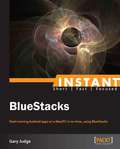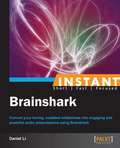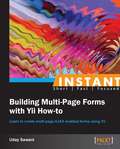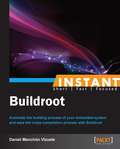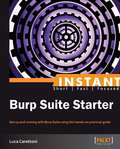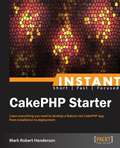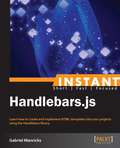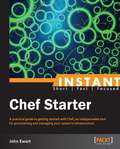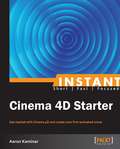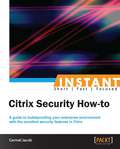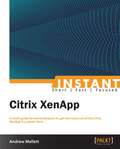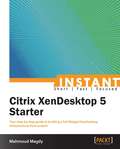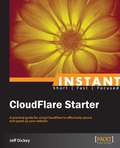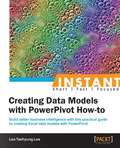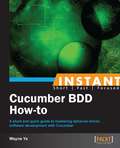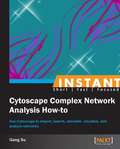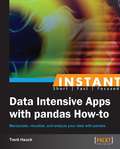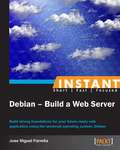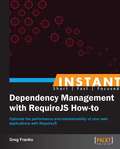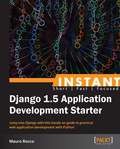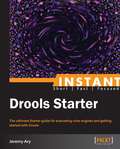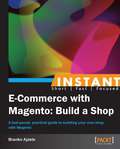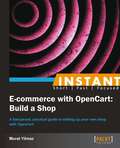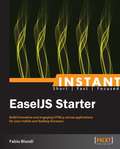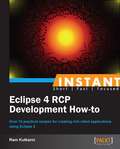- Table View
- List View
Instant BlueStacks
by Gary JudgeGet to grips with a new technology, understand what it is and what it can do for you, and then get to work with the most important features and tasks. A fast-paced, example-based approach guide for learning BlueStacks.This book is for anyone with a Mac or PC who wants to run Android apps on their computer. Whether you want to play games that are freely available for Android but not your computer, or you want to try apps before you install them on a physical device or use it as a development tool, this book will show you how. No previous experience is needed as this is written in plain English so that you can get going with BlueStacks quickly and easily.
Instant BrainShark
by Daniel LiFilled with practical, step-by-step instructions and clear explanations for the most important and useful tasks. "Instant BrainShark" is a step-by-step guide to creating online presentations using BrainShark. The book covers digital marketing best practices alongside tips for sales conversions. The book is written in an easy-to-read style for anybody to easily pick up and get started with BrainShark.Instant BrainShark is for anyone who wants to use BrainShark to create presentations online and share them around the community. The book is also useful for developers who are looking to explore BrainShark as a possible way to market their existing presentations or podcasts.
Instant Building Multi-Page Forms with Yii How-to
by Uday SawantFilled with practical, step-by-step instructions and clear explanations for the most important and useful tasks.A concise guide that delivers immediate results with practical recipes on customizing your forms.This book is great for developers who have a basic understanding of Yii framework and want to learn some of the advanced, inbuilt features of Yii. It assumes that the reader has a basic knowledge of PHP development, how forms work, and AJAX operations.
Instant Buildroot
by Daniel Manchon VizueteFilled with practical, step-by-step instructions and clear explanations for the most important and useful tasks. A concise guide full of step-by-step recipes to help you learn how to generate and configure an embedded Linux system using Buildroot.Instant Buildroot is for developers who want to know how to use Buildroot tools to generate and configure their own embedded system. It is assumed that the reader has some experience with Linux and basic programming and is familiar with basic hardware development boards.
Instant Burp Suite Starter
by Luca CarettoniThis starter guide will lead you through the field of application security with everyday examples explained. Build up your skills and your defenses with this hands-on tutorial. If you are an application developer with a focus on security then this practical guide is for you. Even with basic knowledge of security you will be able to develop your expertise and make your applications bulletproof.
Instant CakePHP Starter
by Mark Robert HendersonGet to grips with a new technology, understand what it is and what it can do for you, and then get to work with the most important features and tasks.This book is a practical, step-by-step tutorial that teaches you about Models, Views, Controllers, scaffolding, themes, behaviors, and routing in CakePHP.This book is for those who have experience in writing HTML/CSS, and a little bit of JavaScript and PHP, and want to learn the basics of CakePHP in an engaging manner.
Instant Cassandra Query Language
by Amresh SinghGet to grips with a new technology, understand what it is and what it can do for you, and then get to work with the most important features and tasks. It's an Instant Starter guide.Instant Cassandra Query Language is great for those who are working with Cassandra databases and who want to either learn CQL to check data from the console or build serious applications using CQL. If you're looking for something that helps you get started with CQL in record time and you hate the idea of learning a new language syntax, then this book is for you.
Instant Chef Starter
by John EwartGet to grips with a new technology, understand what it is and what it can do for you, and then get to work with the most important features and tasks.This is a practical Starter guide which helps you gain the skills needed to learn Chef.This book is aimed at developers and system administrators who are looking for ways to better manage complex infrastructures in a consistent fashion. No previous experience with Chef is assumed.
Instant Cinema 4D Starter
by Aaron KaminarGet to grips with a new technology, understand what it is and what it can do for you, and then get to work with the most important features and tasks.This book is written in a friendly, practical style with lots of screenshots and help that will ensure you grow in confidence chapter by chapter.This book is recommended for artists that have experience in other 3D software packages, and who want to learn Cinema 4D. That being said, dedicated readers without experience in other 3D software should not be discouraged from reading this book to learn the basics of Cinema 4D as their first 3D package.
Instant Citrix Security How-to
by Carmel Veronica JacobFilled with practical, step-by-step instructions and clear explanations for the most important and useful tasks. Get the job done and learn as you go. A how-To book with practical recipes accompanied with rich screenshots for easy comprehension.This easy-to-follow, hands-on guide shows you how to bolster your security with real life cases and step-by-step instructions.This guide gets new users up and running with Citrix Netscaler in simple practical steps and also acts as a refresher to those with some experience of the product and its features.
Instant Citrix XenApp
by Andrew MallettGet to grips with a new technology, understand what it is and what it can do for you, and then get to work with the most important features and tasks. This book is a great tool to quickly learn and explore the features offered by XenApp 6.5.Windows system administrators who want a quick lesson on how to install and configure XenApp.
Instant Citrix XenDesktop 5 Starter
by Mahmoud MagdyGet to grips with a new technology, understand what it is and what it can do for you, and then get to work with the most important features and tasks. This easy-to-follow, hands-on guide shows you how to implement desktop virtualization with real life cases and step-by-step instructions. It is a tutorial with step-by-step instructions and adequate screenshots for the installation and administration of Citrix XenDesktop.If you are new to XenDesktop or are looking to build your skills in desktop virtualization, this is your step-by-step guide to learning Citrix XenDesktop. For those architects and designers experienced in XenDesktop infrastructure implementation this book aims to be a quick reference guide with notes and reminders for their day-to-day tasks.
Instant CloudFlare Starter
by Jeff DickeyWritten as a practical guide, CloudFlare Starter will show you all you need to know in order to effectively improve your online presence in a multitude of different ways."CloudFlare Starter" is a practical yet accessible guide for website owners looking to optimize their site for optimum security and maximum performance.
Instant Creating Data Models with PowerPivot How-to
by Leo Taehyung LeeFilled with practical, step-by-step instructions and clear explanations for the most important and useful tasks. This is a practical, recipe-based book, taking the reader through the hands-on steps required to set up and use PowerPivot with as little fuss as possible.This is an introductory book on PowerPivot for basic Excel users who handle lots of data and are willing to go beyond the limitations of Excel without the need to learn a new language from scratch.
Instant Cucumber BDD How-to
by Wayne YeFilled with practical, step-by-step instructions and clear explanations for the most important and useful tasks. This standard How-to guide explains the essence of Cucumber, describing how to write Cucumber features to drive development in a real project, and also describe many pro tips for writing good Cucumber features and steps.Instant Cucumber BDD How-to is great for an Agile software development team that wants to adopt a behaviour-driven process using Cucumber. It assumes that the team is passionate in reducing communication gaps between developers and product managers, ensuring the development is always on the right track and always focused on minimum marketable value.
Instant Cytoscape Complex Network Analysis How-to
by Gang SuFilled with practical, step-by-step instructions and clear explanations for the most important and useful tasks. Get the job done and learn as you go. A how-To book with practical recipes accompanied with rich screenshots for easy comprehension.This How-to guide offers techniques and skills through recipes. The guide is packed with step-by-step instructions for anyone who wants to learn to use Cytoscape for visualizing networks.This book is great for people who have basic knowledge of programming, network analysis, and Cytoscape usage but would like to visualize and explore some network data. Readers are expected to know the basic concepts of network data, and be capable of using text editing software to edit tabular data which is imported into Cytoscape. Optionally, the user should understand network clustering and command line tools such as R.
Instant Data Intensive Apps with Pandas How-to
by Trent HauckFilled with practical, step-by-step instructions and clear explanations for the most important and useful tasks. This book has a practical approach with step-by-step recipes to help readers get to grips with Pandas.Users of other data analysis tools will find value in seeing tasks they commonly encounter translated to Pandas and users of Python will encounter an introduction to a very impressive tool in a syntax they inherently know. In terms of general skills, it is assumed that the reader understands basic data structures such as arrays or lists dictionaries or hash map as well as having some understanding of command line work. Installing Pandas is not covered, but the online documentation is straightforward. Also, readers are encouraged to use IPython to interact and experiment with the code.
Instant Debian: Build a Web Server
by Jose Miguel ParrellaFilled with practical, step-by-step instructions and clear explanations for the most important and useful tasks. A concise guide full of step-by-step recipes to teach you how to install and configure a Debian web server.This is an ideal book if you are an administrator on a Development Operations team or infrastructure management, who is passionate about Linux and their Web applications but have no previous experience with Debian or APT-based systems.
Instant Dependency Management with RequireJS How-to
by Greg FrankoFilled with practical, step-by-step instructions and clear explanations for the most important and useful tasks.A concise guide that delivers immediate results with practical recipes on customizing your projects.This book is for intermediate to advanced JavaScript developers who are interested in learning more about AMD specification and RequireJS.
Instant Django Application Development Starter
by Mauro RoccoGet to grips with a new technology, understand what it is and what it can do for you, and then get to work with the most important features and tasks. This book is written in a practical Starter style with lots of helpful screenshots and step-by-step tutorials which will guide you gently into the world of Django.This book is for Python developers who want to jump into the world of Django. If you want to create awesome Python web applications without sacrificing speed then this book is for you. This book will also appeal to people learning Python who wish to hit the ground running and develop Python applications quickly and efficiently.
Instant Drools Starter
by Jeremy AryGet to grips with a new technology, understand what it is and what it can do for you, and then get to work with the most important features and tasks.A simple Starter, introducing the Drools concept. The book takes a meticulous approach to providing quick and simple solutions in a practical manner for rules engines and their uses.This book is great for developers, architects, and managers who need to evaluate or get up to speed with Drools engine usage and functionality. This book teaches you to capture and document business processes and represent their maintenance development to business users.
Instant E-Commerce with Magento: Build a Shop
by Ajzele BrankoFilled with practical, step-by-step instructions and clear explanations for the most important and useful tasks. Get the job done and learn as you go. "Instant E-Commerce with Magento: Build a Shop" is written in a friendly, helpful style which takes you through several distinct recipes all geared to getting you started with Magento and selling your products as quickly and as efficiently as possible. The only thing you need to bring to the table is a desire to sell your products online.This book is for anyone who wants to learn how to quickly set up, configure, and manage an online shop with Magento. Regardless of whether you are technically skilled or not, this book will show you show to create a fully functioning e-commerce solution
Instant E-commerce with OpenCart: Build a Shop How-to
by Murat YilmazFilled with practical, step-by-step instructions and clear explanations for the most important and useful tasks. "Instant E-Commerce with OpenCart: Build a Shop How-to" is written in a friendly, helpful style which takes you through several distinct recipes, all geared to getting you started with OpenCart and selling your products as quickly and as efficiently as possible. The only thing you need to bring to the table is a desire to sell your products online."Instant E-Commerce with OpenCart: Build a Shop How-to" is for anyone who wants to learn how to quickly set up, configure, and manage an online shop with OpenCart. Regardless of whether you are technically skilled or not, this book will show you how to create a fully functioning e-commerce solution.
Instant EaselJS Starter
by Fabio BiondiGet to grips with a new technology, understand what it is and what it can do for you, and then get to work with the most important features and tasks.A short and precise guide to get you started with EaselJS , helping you to create some cool applications and games. EaselJS greatly simplifies application development in HTML5 Canvas using a syntax and an architecture very similar to the ActionScript 3.0 language. As a result, Flash / Flex developers will immediately feel at home but it's very easy to learn even if you've never opened Flash in your life. The book targets Web designers, animators, Digital content producers, and Flash and Flex developers. It's assumed that you will have some experience in HTML and pure JavaScript.
Instant Eclipse 4 RCP Development How-to
by Ram KulkarniFilled with practical, step-by-step instructions and clear explanations for the most important and useful tasks.A concise guide that delivers immediate results with practical recipes on learning practical hints and avoiding pitfalls in Eclipse 4 development.You will find this book useful if you are looking to create cross-platform rich client applications. Eclipse platform is built with Java, so basic knowledge of Java is essential. The focus of this book is to understand the new APIs and concepts of the Eclipse 4 platform. Prior knowledge of basic concepts of the Eclipse framework (plugin, extension, perspective, workspace, and so on), SWT (Standard Widget Toolkit), and JFace would be beneficial in understanding the examples in this book quicker.
